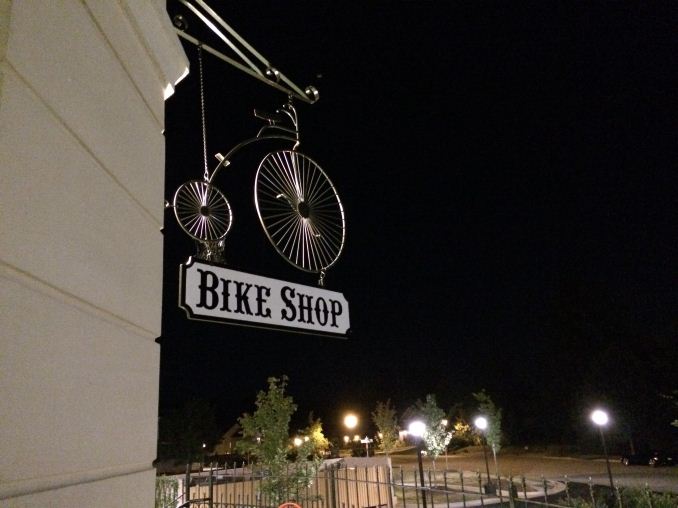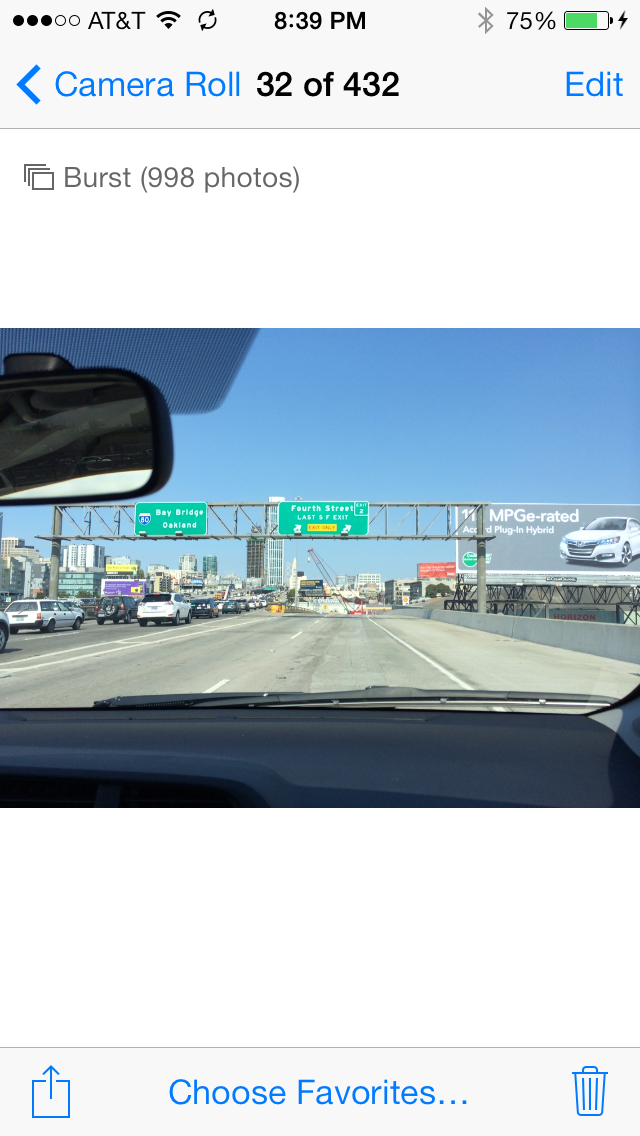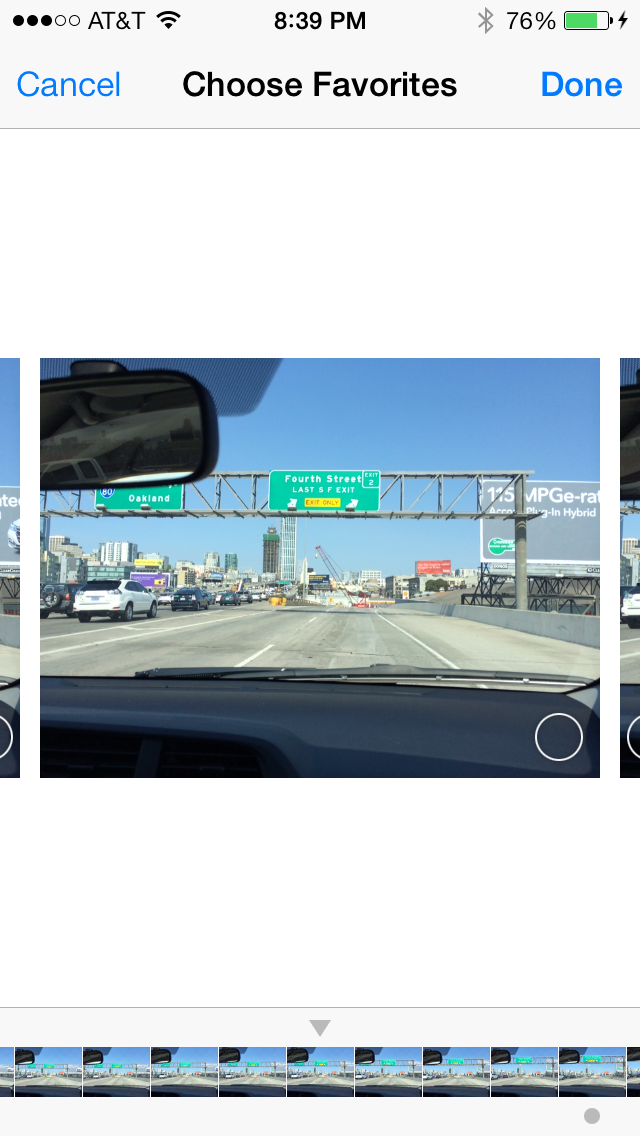The iPhone 5s Review
by Anand Lal Shimpi on September 17, 2013 9:01 PM EST- Posted in
- Smartphones
- Apple
- Mobile
- iPhone
- iPhone 5S
Camera
The iPhone 5s continues Apple’s tradition of sensible improvements to camera performance each generation. I was pleased to hear Phil Schiller deliver a line about how bigger pixels are a better route to improving image quality vs. throwing more at the problem. I remember hearing our own Brian Klug deliver almost that exact same message a year earlier when speaking to some engineers at another phone company.
The iPhone 5s increases sensor size compared to the iPhone 5. Last week Brian dug around and concluded that the 5s’ iSight camera sensor likely uses a format very similar to that of the HTC One. The difference here is while HTC opted for even larger pixels (arriving at 4MP), Apple chose a different balance of spatial resolution to light sensitivity with its 8MP sensor.
One thing ingrained in my mind from listening to Brian talk about optics is that there is no perfect solution, everything ultimately boils down to a selection of tradeoffs. Looking at Apple/HTC vs. the rest of the industry we see one set of tradeoffs, with Apple and HTC optimizing for low light performance while the rest of the industry chasing smaller pixel sizes. Even within Apple and HTC however there are differing tradeoffs. HTC went more extreme in pixel size while Apple opted for more spatial resolution.
| iPhone 4, 4S, 5, 5S Cameras | ||||
| Property | iPhone 4 | iPhone 4S | iPhone 5 | iPhone 5S |
| CMOS Sensor | OV5650 | IMX145 | IMX145-Derivative | ? |
| Sensor Format |
1/3.2" (4.54x3.42 mm) |
1/3.2" (4.54x3.42 mm) |
1/3.2" |
~1/3.0" (4.89x3.67 mm) |
| Optical Elements | 4 Plastic | 5 Plastic | 5 Plastic | 5 Plastic |
| Pixel Size | 1.75 µm | 1.4 µm | 1.4 µm | 1.5 µm |
| Focal Length | 3.85 mm | 4.28 mm | 4.10 mm | 4.12 mm |
| Aperture | F/2.8 | F/2.4 | F/2.4 | F/2.2 |
| Image Capture Size |
2592 x 1936 (5 MP) |
3264 x 2448 (8 MP) |
3264 x 2448 (8 MP) |
3264 x 2448 (8 MP) |
| Average File Size | ~2.03 MB (AVG) | ~2.77 MB (AVG) | ~2.3 MB (AVG) | 2.5 MB (AVG) |
Apple moved to 1.5µm pixels, up from 1.4µm in the iPhone 5. Remember that we’re measuring pixel size in a single dimension, so the overall increase in pixel size amounts to around 15%. Apple also moved to a faster aperture (F/2.2 vs. F/2.4 on the iPhone 5) to increase light throughput. The combination can result in significantly better photos than the outgoing 5 when taking photos in low light.
With the move to larger pixels, Apple has done away with its 2x2 binning mode in low light settings. The iPhone 5 would oversample each pixel after scene brightness dropped below a certain threshold to improve low light performance. The oversampled image would then be upscaled to the full 8MP, trading off spatial resolution for low light performance. The iPhone 5s doesn’t have to make this tradeoff. In practice I didn’t find any situations where the 5s’ low light performance suffered as a result. It always seemed to produce better shots than the iPhone 5.
Unlike some of the larger flagships we’ve reviewed lately, the iPhone 5s doesn’t ship with optical image stabilization (OIS). We’ve seen devices from HTC, LG and Nokia all ship with OIS, and have generally been pleased with the results. It’s not a surprise that the 5s doesn’t come with OIS as it’s largely the same physical platform as the outgoing 5. Still it would be great to see an Apple device ship with OIS. Perhaps on a larger iPhone.
As is always the case in space constrained camera systems, what Apple could not achieve in the physical space it hopes to make up for computationally. The 5s leverages electronic image stabilization as well as automatic combination of multiple frames from the capture buffer in order to deliver the sharpest shots each time.
Apple’s cameras have traditionally been quite good, not just based on sensor selection but looking at the entire stack from its own custom ISP (Image Signal Processor) and software. With the A7 Apple introduces a brand new ISP. Although we know very little about the new ISP, you can find references to Apple’s H6 ISP if you dig around.

Apple continues to ship one of the better auto modes among smartphone cameras I've used. I still want the option of full manual controls, but for most users Apple's default experience should be a very good one.
Capturing shots under iOS 7 is incredibly quick. Shot to shot latency is basically instantaneous now, thanks to a very fast ISP and the A7’s ability to quickly move data in and out of main memory. It’s impossible to write shots to NAND this quickly so Apple is likely buffering shots to DRAM before bursting them out to non-volatile storage.
The new ISP enables a burst capture mode of up to 10 fps. To active burst mode simply hold down the shutter button and fire away. The iPhone 5s will maintain a 10 fps capture rate until the burst counter hits 999 images (which was most definitely tested). Although it took a while to write all 999 images, all of them were eventually committed to NAND.
Photos captured in burst mode are intelligently combined as to not clutter your photo gallery. The camera app will automatically flag what it thinks are important photos, but you’re free to choose as many (or as few) as you’d like to include in your normal browsing view. Since all of the photos captured in burst mode are physically saved, regardless of whether or not you select them to appear among your photos, you can always just pull them off the 5s via USB.
The rear facing camera is paired with a new dual-LED True Tone flash. Rather than featuring a single white LED to act as a flash, Apple equips the iPhone 5s with two LEDs with different color tones (one with a cool tone and one with a warm tone). When set to fire, the 5s’ ISP and camera system will evaluate the color temperature of the scene, pre-fire the flash and determine the right combination of the two LEDs to produce the most natural illumination of the subject.
I’m not a huge fan of flashes, but I have to say that in a pinch the True Tone flash is appreciably better than the single LED unit on the iPhone 5. Taking photos of people with the new True Tone flash enabled produces much warmer and more natural looking results:
Even if your subject happens to be something other than a person I’ve seen really good results from Apple’s True Tone flash.
I still believe the best option is to grab your photo using natural/available light, but with a smartphone being as portable as it is that’s not always going to be an option.
I have to say I appreciate the vector along which Apple improved the camera experience with the iPhone 5s. Improving low light performance (and quality in low light situations where you’re forced to use a flash) is a great message to carry forward.
Front Facing Camera
The iPhone 5s and iPhone 5c share the same upgraded front-facing FaceTime HD camera. The front facing camera gets a sensor upgrade, also with a move to larger pixels (1.9µm up from 1.75µm) while resolution and aperture remain the same at 720p and F/2.4. The larger sensor size once again improves low light performance of the FaceTime HD camera (iPhone 5 left vs. iPhone 5s right):
































464 Comments
View All Comments
Wilco1 - Wednesday, September 18, 2013 - link
If all you can do is name calling then you clearly haven't got a clue or any evidence to prove your point. Either come up with real evidence or leave the debate to the experts. Do you even understand what IPC means?For example in your link a low clocked Jaguar is keeping up with a much higher clocked Bay Trail (yes it boosts to 2.4GHz during the benchmark run), so the obvious conclusion is that Jaguar has far higher IPC than Bay Trail. For example Jaguar has 28% higher IPC than BT in the 7-zip test. Just like I said.
Now show me a single benchmark where BT gets better IPC than Jaguar. Put up or shut up.
zeo - Wednesday, September 18, 2013 - link
The point that BT Beats Jaguar, especially at performance per watt, clearly proved the point given!And insisting as you are on your original assessment is a characteristic of acting like a Troll... So you're not going to convince anyone by simply insisting on being right... especially when we can point to Anandtech pointing out multiple benchmarks in this article that showed the Kabini performing lower than bother BT and the A7!
So either learn to read what these reviews actually post or accept getting labeled a Troll... either way, you're not winning this argument!
Wilco1 - Wednesday, September 18, 2013 - link
No, Bob's claim was that Bay Trail was faster clock for clock than Jaguar, when the link he gave to prove it clearly showed that is false. BT may well beat Jaguar on perf/watt, but that's not at all what we were discussing.So next time try to understand what people are discussing before jumping in and calling people a Troll. And yes I stand by my characterization of various microarchitectures, precisely because it's based on actual benchmark results.
Bob Todd - Wednesday, September 18, 2013 - link
IPC as a comparison point made a lot of sense when we were arguing about which 130 watt desktop processor had the better architecture. It seems largely irrelevant for mobile where we care about performance per watt. Your argument is continually that the ARM/AMD designs are 'faster' based on Geekbench. If Jaguar has a 28% higher IPC than Bay Trail, do you honestly think it matters if Bay Trail is still the faster chip @ 1/3 (or less) of the power requirements? If someone came up with a crazy design that needed 5x the clocks to have a 2x performance advantage of their competitor, but did so with half the power budget, they'd still be racking up design wins (assuming parity for all other aspects like price). That's a two way street. If ARM designs a desktop/server focused chip that needs higher clocks than Intel to reach performance parity or be faster than Haswell, but does so with significantly less power it's still a huge win for them.Wilco1 - Wednesday, September 18, 2013 - link
IPC matters as you can compare different microarchitectures and make predictions on performance at different clock speeds. I'm sure you know many CPUs come in a confusing variation of clockspeeds (and even different base/turbo frequencies for Intel parts), but the underlying microarchitecture always remains the same. You can't make claims like "Bay Trail is faster than Jaguar" when such a claim would only valid at very specific frequencies. However we can say that Jaguar has better IPC than BT and that will remain true irrespectively of the frequency. So that is the purpose of the list of microarchitectures I posted.I was originally talking about the performance of Apple A7 and Bay Trail in Geekbench. You may not like Geekbench, but it represents close to actual CPU performance (not rubbish JavaScript, tuned benchmarks, cheating - remember AnTuTu? - or unfair compiler tricks).
Now you're right that besides absolute performance, perf/W is also important. Unfortunately there is almost no detailed info on power consumption, let alone energy to do a certain task for various CPUs. While TDP (in the rare cases it is known!) can give some indication, different feature sets, methodologies, "dial-a-TDP" and turbo features makes them hard to compare. What we can say in general is that high-frequency designs tend to be less efficient and use more power than lower frequency, higher IPC designs. In that sense I would not be surprised if the A7 also shows a very good perf/Watt. How it compares with BT is not clear until BT phones appear.
Bob Todd - Wednesday, September 18, 2013 - link
Your point about benchmarks is actually what surprises me the most nowadays. The biggest thing every in-depth review of a new ARM design brings to light is how freaking piss poor the state of mobile benchmarking is from a software standpoint. I didn't expect magic by the time we got to A9 designs, but it's a little ridiculous that we're still in a state of infancy for mobile benchmarking tools over half a decade after the market really started heating up.Bob Todd - Wednesday, September 18, 2013 - link
And by "ARM design" I mean both their cores or others building to their ISA.Wilco1 - Thursday, September 19, 2013 - link
Yes, mobile benchmarking is an absolute disgrace. And that's why I'm always pointing out how screwed up Anand's benchmarking is - I'm hoping he'll understand one day. How anyone can conclude anything from JS benchmarks is a total mystery to me. Anand might as well just show AnTuTu results and be done with it, that may actually be more accurate!Mobile benchmarks like EEMBC, CoreMark etc are far worse than the benchmarks they try to replace (eg. Dhrystone). And SPEC is useless as well. Ignoring the fact it is really a server benchmark, the main issue is that it ended up being a compiler trick contest than a fair CPU benchmark. Of course Geekbench isn't perfect either, but at the moment it's the best and fairest CPU bench: because it uses precompiled binaries you can't use compiler tricks to pretend your CPU is faster.
akdj - Thursday, September 19, 2013 - link
SO.....what is it the 'crew' is supposed to 'do'? NOT provide ANY benchmarks? Anand and team are utilizing the benchmarks available right now. They're not building the software to bench these devices...they're reviewing them...with the tools available, currently, NOW---on the market. If you're so interested in better mobile benchmarking (still in it's infancy---it's only really been 5 years since we've had multiple devices to even test), why not pursue and build your own benchmarking software? Seems like it may be a lucrative project. Sounds like you know a bit about CPU/GPU and SoC architecture---put something together. Sunspider is ubiquitous, used on any and all platforms from desktops to laptops---tablets to phones, people 'get it'. As well, GeekBench is re-inventing their benchmarking software---as well, the Google Octane tests are fairly new...and many of the folks using these devices ARE interested in how fast their browser populates, how quick a single core is---speed of apps opening and launching, opening a PDF, FPS playing games, et al.Again---if you're not 'happy' with how Anand is reviewing gear (the best on the web IMHO), open your own site---build your own tools, and lets see how things turn out for ya!
Give credit where credit is due....I'd much rather see the way Anand is approaching reviews in the mobile sector than a 1500 word essay without benchmarking results because current "mobile benchmarking is an absolute disgrace"
YMMV as always
J
PS---Thanks for the review guys....again, GREAT Job!
Bob Todd - Thursday, September 19, 2013 - link
Umm...I think you missed my point. I love the reviews here. That doesn't change the fact that mobile benchmarking software sucks compared to what we have available on the desktop. That isn't a slam against this site or any of the reviewers, and I fully expect them to use the (relatively crappy) software tools that are available. And they've even gone above and beyond and written some tools themselves to test specific performance aspects. I'm just surprised that with mobile being the fastest growing market, nobody has really stepped up to the plate to offer a good holistic benchmarking suite to measure cpu/gpu/memory/io performance across at least iOS/Android. And no, I don't expect anyone at Anandtech to write or pay someone to write such a tool.